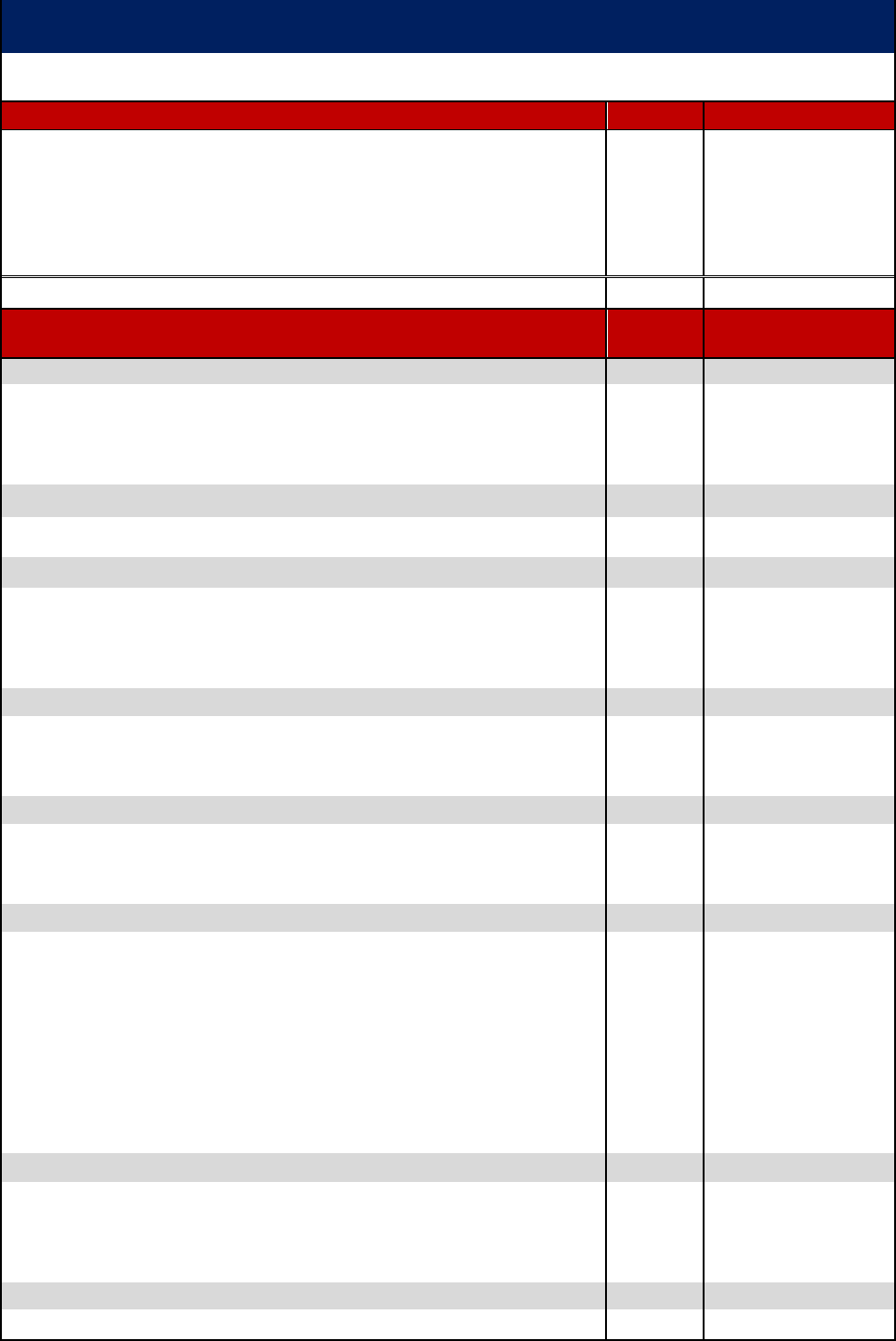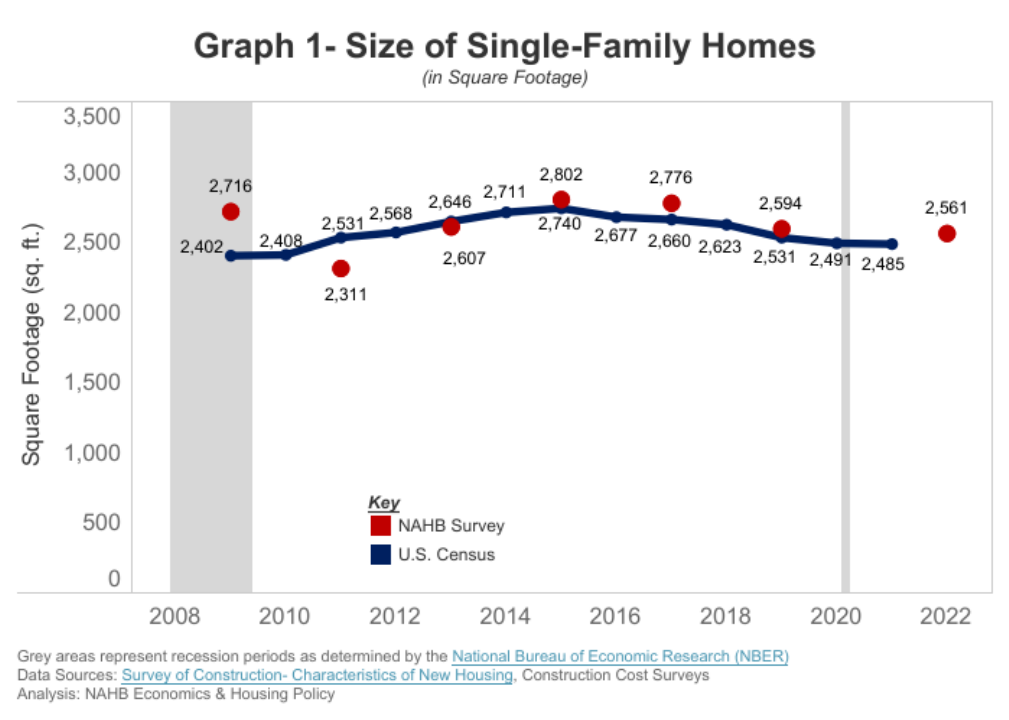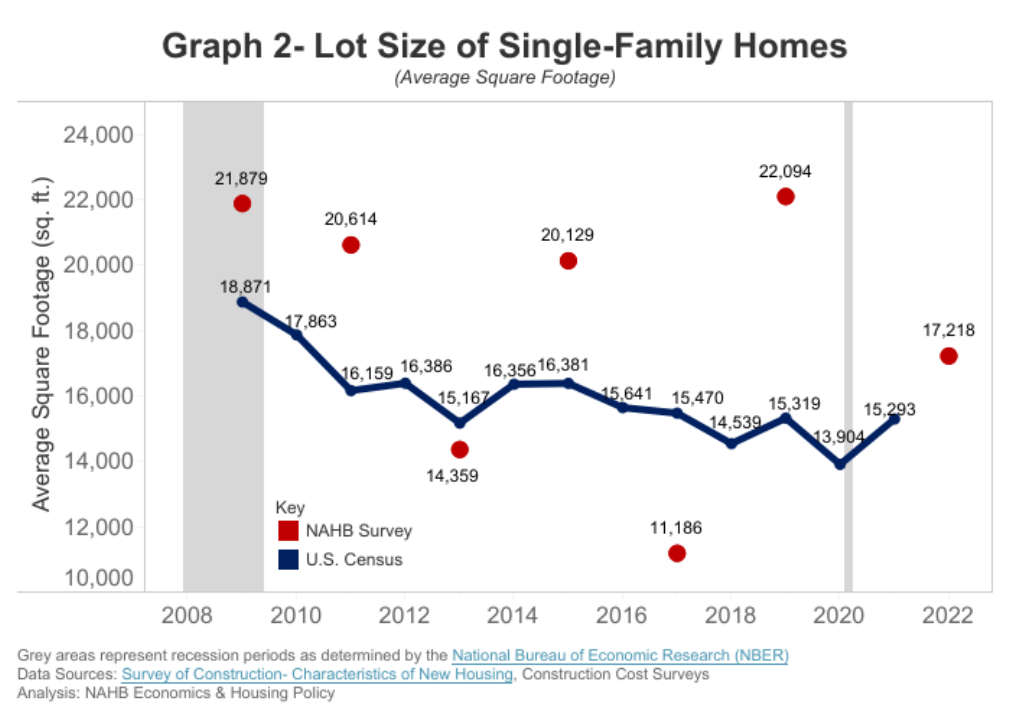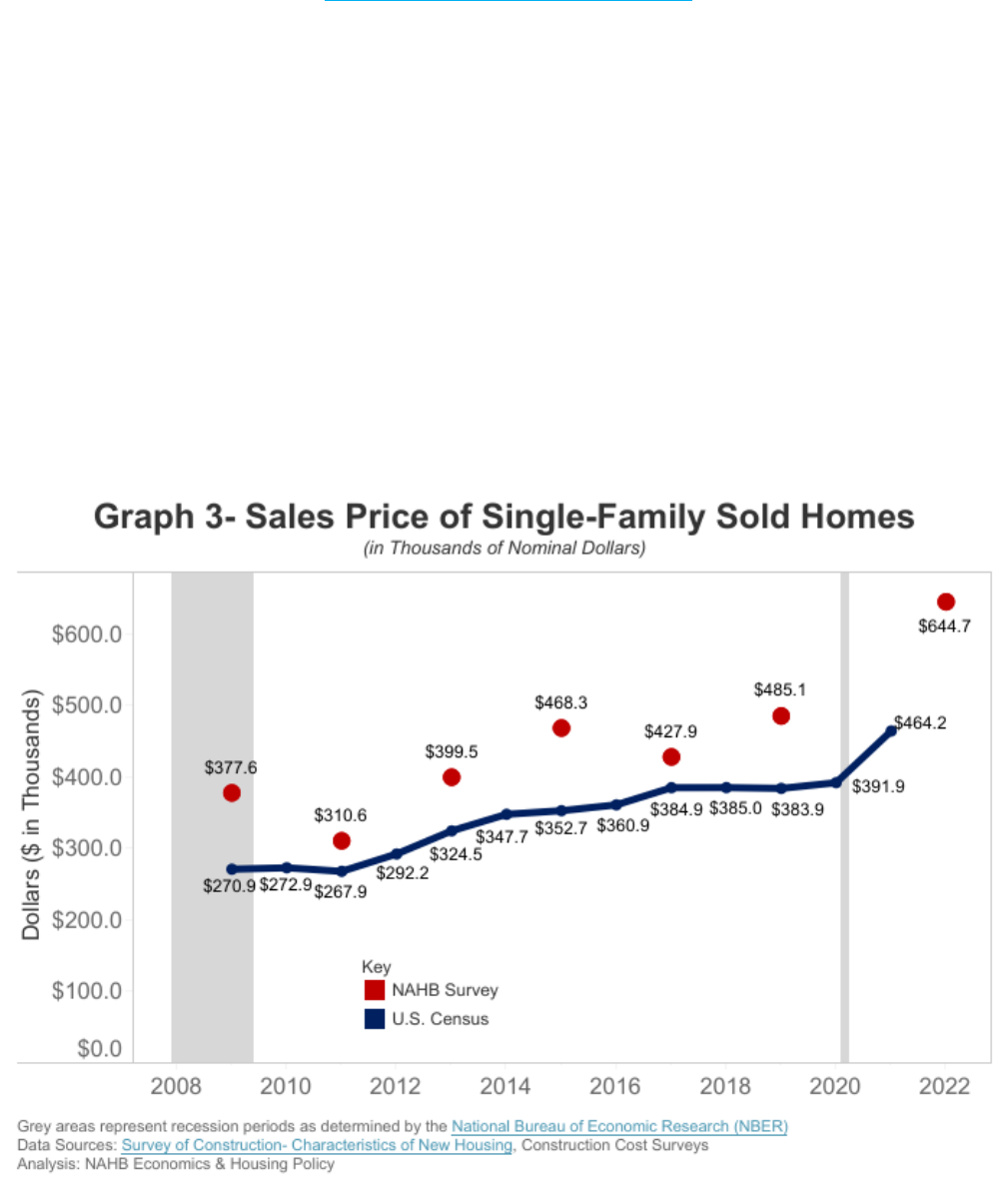
Cost of Constructing a Home- 2022
February 1, 2023
By: Eric Lynch
Economics & Housing Policy
National Association of Home Builders (NAHB)
Introduction
Over the years, NAHB has periodically conducted “construction cost surveys” to collect information from
builders on the various components that go into the sales price of a typical newly-built single-family home.
NAHB’s most recent Construction Cost survey (conducted in the Fall of 2022) shows that, on average,
60.8 percent of the sales price is due to construction costs and 17.8 percent to finished lot costs. On
average, builder profit is 10.1 percent of the sales price. The following sections describe the methodology
of the survey and discuss the results in more detail.
Caveats
The NAHB Construction Cost Survey is designed to show percentage cost breakdowns for a typical home
built by a subset of NAHB builders. It is not designed to capture representative characteristics of the
average home built during a particular year. Characteristics such as the size or price of homes in the
sample may therefore differ significantly from averages reported in the Census Bureau’s Survey of
Construction (SOC), which is based on a much larger sample and is designed to produce such averages.
Because the NAHB survey does not control for year-to-year differences in the builders or homes in the
sample, users should be cautious when comparing results across multiple years and defer to the published
SOC data for this purpose when possible.
The survey results published here are national averages; as the survey sample is not large enough for a
geographic breakdown. Building practices, the cost of labor, the cost of land, and to some extent the cost
of materials can vary from place to place and depend on the nature of the specific home being built. Each
category includes all the costs paid by a builder that go into a particular item, including labor costs paid
directly by the general contractor, the cost of hiring subcontractors, and the cost of materials, however
they are purchased.
Although the survey can provide a broad idea of construction costs for the average new single-family
home, it is not a perfect tool for estimating costs for a particular house in a particular location. Companies
that provide more specific cost estimating, usually for a fee, include RSMeans and Marshall & Swift.
Methodology
NAHB’s 2022 Construction Cost survey was conducted by emailing a questionnaire to a representative
sample of 3,891 home builders. The sample was stratified by the size of the builder (based on the number
of 2021 single-family starts) and by region of the country (the sample being proportional to housing starts
in each of the four principal Census regions).
Over the years, NAHB has modified the survey and its methodology. In 2009, the survey methodology
changed to provide a better, more representative sample of single-family construction across the country.
In 2013, NAHB developed a different construction cost breakdown that more closely resembles the steps
that builders take when building a home. Prior to 2013, the breakdown had 29 sections. In 2013, NAHB
created eight subcategories for each of the major stages of construction, with a total of 36 sections grouped
under the appropriate construction stage. The new format simplified data collection, greatly reducing the
number of follow-up calls needed to clarify and verify builder responses.
Respondents were asked to provide information about the typical single-family home built by their firms
during 2022. After examining the data and performing an outlier analysis, usable responses were received
from 49 builders. Table 1 shows the detailed results of the 2022 Construction Cost survey.

Table 1. SINGLE-FAMILY PRICE AND COST BREAKDOWNS
2022 National Results
Average Lot Size:
17,218
Average Finished Area:
2,561
I. Sale Price Breakdown
Average
Share of Price
A. Finished Lot Cost (including financing cost)
$114,622
17.8%
B. Total Construction Cost
$392,241
60.8%
C. Financing Cost
$12,192
1.9%
D. Overhead and General Expenses
$32,979
5.1%
E. Marketing Cost
$4,268
0.7%
F. Sales Commission
$23,080
3.6%
G. Profit
$65,369
10.1%
Total Sales Price
$644,750
100.0%
II. Construction Cost Breakdown
Average
Share of
Construction Cost
I. Site Work (sum of A to E)
$29,193
7.4%
A. Building Permit Fees
$8,292
2.1%
B. Impact Fee
$5,208
1.3%
C. Water & Sewer Fees Inspections
$5,800
1.5%
D. Architecture, Engineering
$4,724
1.2%
E. Other
$5.169
1.3%
II. Foundations (sum of F to G)
$43,086
11.0%
F. Excavation, Foundation, Concrete, Retaining walls, and Backfill
$39,731
10.1%
G. Other
$3,355
0.9%
III. Framing (sum of H to L)
$80,280
20.5%
H. Framing (including roof)
$60,831
15.5%
I. Trusses (if not included above)
$11,479
2.9%
J. Sheathing (if not included above)
$5,383
1.4%
K. General Metal, Steel
$1,168
0.3%
L. Other
$1,419
0.4%
IV. Exterior Finishes (sum of M to P)
$46,108
11.8%
M. Exterior Wall Finish
$19,746
5.0%
N. Roofing
$11,496
2.9%
O. Windows and Doors (including garage door)
$13,158
3.4%
P. Other
$1,709
0.4%
V. Major Systems Rough-ins (sum of Q to T)
$70,149
17.9%
Q. Plumbing (except fixtures)
$22,706
5.8%
R. Electrical (except fixtures)
$23,892
6.1%
S. HVAC
$21,845
5.6%
T. Other
$1,707
0.4%
VI. Interior Finishes (sum of U to AE)
$94,300
24.0%
U. Insulation
$6,530
1.7%
V. Drywall
$13,184
3.4%
W. Interior Trims, Doors, and Mirrors
$12,727
3.2%
X. Painting
$8,793
2.2%
Y. Lighting
$4,502
1.1%
Z. Cabinets, Countertops
$17,775
4.5%
AA. Appliances
$6,263
1.6%
AB. Flooring
$13,019
3.3%
AC. Plumbing Fixtures
$5,166
1.3%
AD. Fireplace
$1,608
0.4%
AE. Other
$4,733
1.2%
VII. Final Steps (sum of AF to AJ)
$23,065
5.9%
AF. Landscaping
$9,123
2.3%
AG. Outdoor Structures (deck, patio, porches)
$2,178
0.6%
AH. Driveway
$8,775
2.2%
AI. Clean Up
$2,280
0.6%
AJ. Other
$709
0.2%
VIII. Other
$6,059
1.5%
Total
$392,241
100.0%

Home and Lot Size
The average single-family home size in the 2022 NAHB Construction Cost Survey is 2,561 sq. ft. of
finished floor space, the smallest square footage since 2011. Historically, average square footage in the
NAHB survey has tended to move in the same direction as in the Census Bureau’s series with a lag, and
with wider fluctuations, as you would expect from the smaller sample size.
The average home size dropped from 2,716 sq. ft. in 2009 to 2,311 sq. ft. in 2011, as demand eroded after
the Great Recession. As the economy recovered, it rose steadily and peaked at 2,802 sq. ft. in 2015. Since
then, the average square footage has trended downward, dropping to 2,776 sq. ft. in 2017, 2,594 sq. ft. in
2019, and 2,561 sq. ft. in 2022 (Graph 1). Data from the Census Bureau corroborates this trend: the
average size of new homes completed for-sale peaked in 2015 at 2,740 sq. ft., but has declined every year
since then. In 2021, the average size fell to 2,485 sq. ft., which is the lowest level since 2010. The smaller
square footage in recent years is evidence that builders have shifted toward the production of more entry-
level homes to meet demand for more affordable homes.
The average lot size in the 2022 NAHB Construction Cost Survey is 17,218 sq. ft., or less than a half-acre
(1 acre is equivalent to 43,560 sq. ft.). There have been high levels of volatility in average lot size over

the years. It exceeded 20,000 sq. ft. in both 2009 and 2011, , dropped to 14,359 sq. ft. in 2013, rebounded
to 20,129 sq. ft. in 2015, but dropped again to 11,186 sq. ft. in 2017 (the smallest lot size since the inception
of the survey). In 2019, average lot size jumped up to 22,094 sq. ft., the largest lot size recorded in this
series.
In general, lot size in the NAHB survey has tended to move in the same direction as the Census series, but
as mentioned previously, with increased volatility from year to year (Graph 2). The Census data show a
downward trend in lot size between 2009 and 2013, dropping from an average of 18,871 sq. ft. to a low
of 15,167 sq. ft. in 2013. It rebounded to 16,381 sq. ft. in 2015, dropped steadily from 2016 to 2018, before
see-sawing during the last three years. In 2021, the average lot size of homes completed for sale was
15,293 sq. ft..
Sales Price
The average single-family home sales price in the 2022 NAHB Construction Cost Survey is $644,750, the
highest average sales price (not adjusted for inflation) in the survey’s history. The Census Bureau’s series
shows the average price for new single-family homes sold increasing steadily after the Great Recession,

going from $267,900 in 2011 to $385,000 in 2018, dropping slightly in 2019, before rising again in 2020
and 2021 – when it reached $464,200 (Graph 3). The surge in demand for housing during the COVID-19
pandemic, which exacerbated the shortage of the current housing supply, helps to explain the most recent
price increases seen post-2020.
Compared to the Census series, the NAHB survey shows a similar upward trend, but with generally higher
prices. The $644,750 reported by NAHB in 2022 in particular is roughly $180,000 higher than the latest
average price reported by the Census Bureau. Recall that the NAHB survey is not designed to generate a
national average home price. For one thing, the NAHB survey does not control for the number of homes
a builder builds, which gives more weight to smaller builders who may tend to build higher-priced homes.
Timing is also a factor in the spread between the average prices reported by NAHB and the Census Bureau.
The NAHB survey was conducted toward the end of 2022. The latest annual average price of $464,200
available from the Census Bureau is for calendar year 2021. Subsequent monthly data from the Census
Bureau show the average price rising to $543,600 as of November 2022.

Sales Price Breakdown
A key feature of the NAHB survey is that it asks builders to break down the sales price of their homes
into seven categories: finished lot cost, total construction cost, financing cost, overhead and general
expenses, marketing costs, sales commission, and profit. Table 2 contains historical information on the
sales price breakdown of a single-family home. It is important to remind readers to use caution when
comparing data across years in Table 2, as trends may be affected by the survey’s sample size limitations
and the fact that a different set of builders responds to the survey each time.
On average in the 2022 NAHB survey, 60.8 percent of the final house price was attributable to
construction costs, 17.8 percent to the cost of the finished lot, 5.1 percent to overhead and general
expenses, 3.6 percent to sales commissions, 1.9 percent to financing costs, 0.7 percent to marketing costs,
leaving 10.1 percent for profit (prior to taxes). Since 1998, the long-run average in the pre-tax profit share
stands at 9.7%.
No component category experienced a larger than 1 percentage point change between 2019 and 2022. As
a share of the average sales price, finished lot cost dropped from 18.5% in 2019 to 17.8% in 2022, followed
by total construction cost (61.1% to 60.8%), marketing cost (1.0% to 0.7%), and sales commission (3.7%
to 3.6%). Average profit rose from 9.1% in 2019 to 10.1% in 2022, followed by overhead and general
expenses (4.9% to 5.1%) and financing cost (1.7% to 1.9%).
Table 2. SINGLE-FAMILY HOMES SALES PRICE BREAKDOWN HISTORY
Source: NAHB Construction Cost Surveys, 1998-2022
Construction Costs
The average construction cost of a typical single-family home in the 2022 survey is $392,241 (Table 3),
or about $153 per square foot – the highest in the history of this series. The cost of construction per square
foot was $80 in 2011, $95 in 2013, $103 in 2015, $86 in 2017, and $114 in 2019.
Sale Price Breakdown 1998 2002 2004 2007 2009 2011 2013 2015 2017 2019 2022
1. Finished Lot Cost 23.6% 23.5% 26.0% 24.5% 20.3% 21.7% 18.6% 18.2% 21.5% 18.5% 17.8%
2. Total Construction Cost 54.8% 50.8% 51.7% 48.1% 58.9% 59.3% 61.7% 61.8% 55.6% 61.1% 60.8%
3. Financing Cost 1.9% 2.1% 1.8% 2.4% 1.7% 2.1% 1.4% 1.3% 1.8% 1.7% 1.9%
4. Overhead and General Expenses 5.7% 5.5% 5.8% 7.0% 5.4% 5.2% 4.3% 5.6% 5.1% 4.9% 5.1%
5. Marketing Cost 1.4% 2.4% 1.9% 2.5% 1.4% 1.5% 1.1% 0.8% 1.2% 1.0% 0.7%
6. Sales Commission 3.4% 3.7% 3.0% 4.3% 3.4% 3.3% 3.6% 3.2% 4.1% 3.7% 3.6%
7. Profit 9.2% 12.0% 9.8% 11.2% 8.9% 6.8% 9.3% 9.0% 10.7% 9.1% 10.1%
8. Total Sales Price ($)
226,680$ 298,412$ 373,349$ 454,906$ 377,624$ 310,619$ 399,532$ 468,318$ 427,892$ 485,128$ 644,750$

Of the 8 major stages of construction, interior finishes, at 24.0%, accounts for the largest share of
construction costs, followed by framing (20.5%), major system rough-ins (17.9%), exterior finishes
(11.8%), foundations (11.0%), site work (7.4 percent), final steps (5.9%), and other costs (1.5 percent)
(See Table 3 for a full breakdown).
Major system rough-ins and framing had the largest percentage point increases from 2019 to 2022, rising
from 14.7% to 17.9% and from 17.4% to 20.5%, respectively. On the other hand, exterior finishes
experienced the largest percentage point decrease from 2019 to 2022, falling from 14.1% to 11.8%.
Of the detailed items (i.e., subcomponents) in the NAHB survey, framing (including roofing), at 15.5%,
and excavation, foundation, concrete, retaining walls, and backfill, at 10.1%, had the largest shares of
construction costs. Together, these two subcomponents account for just over a quarter (25.6%) of 2022’s
construction costs, slightly up from the 25.0% they represented in 2019. Based on the latest analysis of
the Producer Price Index (PPI) from NAHB, lumber and ready-mix concrete prices were extremely
volatile and experienced high peaks in 2022, which can help to explain these subcomponent increases
from the previous year’s survey.

Table 3. SINGLE-FAMILY CONSTRUCTION COST BREAKDOWN HISTORY
Source: NAHB Construction Cost Surveys, 1998-2022
Construction Cost Breakdown 1998 2002 2004 2007 2009 2011 2013 2015 2017 2019 2022
I. Site Work (sum of A to E) 6.8% 5.6% 6.7% 6.2% 7.4%
A. Building Permit Fees 0.9% 1.3% 0.8% 1.7% 1.9% 1.7% 1.5% 1.2% 1.7% 1.7% 2.1%
B. Impact Fee 1.0% 1.6% 1.1% 1.4% 1.4% 1.5% 1.3% 0.6% 0.9% 1.3% 1.3%
C. Water & Sewer Fees Inspections 1.0% 1.4% 1.2% 1.6% 1.7% 1.6% 1.8% 1.4% 2.0% 1.5% 1.5%
D. Architecture, Engineering 1.5% 1.6% 1.4% 1.5% 1.2%
E. Other 0.7% 0.7% 0.7% 0.2% 1.3%
II. Foundations (sum of F to G) 9.5% 11.6% 10.8% 11.8% 11.0%
F. Excavation, Foundation, Concrete, Retaining
walls, and Backfill
9.6% 6.9% 9.9% 7.0% 7.1% 9.3% 9.3% 11.3% 10.7% 11.3% 10.1%
G. Other 0.2% 0.3% 0.1% 0.5% 0.9%
III. Framing (sum of H to L) 19.1% 18.0% 17.3% 17.4% 20.5%
H. Framing (including roof) 14.8% 15.4% 15.0% 13.7% 15.5%
I. Trusses (if not included above) 2.2% 1.3% 1.6% 2.1% 2.9%
J. Sheathing (if not included above) NA 0.9% 1.4% 1.6% 1.7% 1.2% 0.9% 0.4% 0.3% 1.1% 1.4%
K. General Metal, Steel 1.1% 0.8% 0.3% 0.8% 0.7% 0.5% 0.7% 0.4% 0.3% 0.3% 0.3%
L. Other 0.5% 0.3% 0.1% 0.2% 0.4%
IV. Exterior Finishes (sum of M to P) 14.4% 15.0% 13.9% 14.1% 11.8%
M. Exterior Wall Finish 6.8% 7.2% 6.5% 6.5% 5.0%
N. Roofing 2.6% 2.6% 2.2% 3.2% 3.8% 2.9% 3.2% 3.5% 3.3% 3.4% 2.9%
O. Windows and Doors (including garage door) 4.1% 4.2% 3.9% 4.0% 3.4%
P. Other 0.2% 0.2% 0.3% 0.2% 0.4%
V. Major Systems Rough-ins (sum of Q to T) 13.4% 13.1% 13.8% 14.7% 17.9%
Q. Plumbing (except fixtures) 5.9% 5.4% 5.3% 5.4% 5.3% 6.0% 4.8% 4.3% 4.6% 5.0% 5.8%
R. Electrical (except fixtures) 3.8% 3.3% 3.4% 3.9% 3.7% 4.4% 4.0% 4.2% 4.2% 4.6% 6.1%
S. HVAC 4.1% 4.2% 3.7% 3.9% 4.0% 4.8% 4.5% 4.4% 4.7% 4.8% 5.6%
T. Other 0.1% 0.3% 0.2% 0.3% 0.4%
VI. Interior Finishes (sum of U to AE) 29.3% 29.6% 28.6% 25.4% 24.0%
U. Insulation 1.4% 1.6% 1.4% 1.6% 1.5% 1.8% 1.9% 2.2% 2.2% 1.7% 1.7%
V. Drywall 5.5% 5.3% 4.9% 5.1% 5.1% 4.4% 3.8% 4.1% 4.4% 3.6% 3.4%
W. Interior Trims, Doors, and Mirrors 4.3% 4.3% 4.6% 3.6% 3.2%
X. Painting 3.8% 3.6% 3.6% 3.4% 3.4% 3.3% 3.4% 3.1% 3.0% 2.8% 2.2%
Y. Lighting 1.0% 0.8% 0.9% 1.0% 1.1% 1.2% 1.2% 1.2% 1.3% 1.2% 1.1%
Z. Cabinets, Countertops 5.0% 4.3% 6.6% 5.7% 5.6% 5.6% 5.2% 5.5% 5.0% 4.6% 4.5%
AA. Appliances 1.3% 1.2% 1.3% 1.7% 1.6% 2.0% 1.7% 1.5% 1.5% 1.6% 1.6%
AB. Flooring 4.8% 4.3% 4.2% 5.0% 5.1% 4.5% 5.0% 4.6% 4.3% 4.0% 3.3%
AC. Plumbing Fixtures 1.7% 1.5% 1.3% 1.4% 1.3%
AD. Fireplace 0.8% 1.0% 0.6% 0.6% 0.4%
AE. Other 0.2% 0.5% 0.4% 0.3% 1.2%
VII. Final Steps (sum of AF to AJ) 6.6% 6.8% 7.0% 6.8% 5.9%
AF. Landscaping 1.8% 2.5% 2.6% 2.8% 3.2% 3.5% 2.3% 2.1% 2.5% 2.2% 2.3%
AG. Outdoor Structures (deck, patio, porches) 0.7% 0.7% 1.0% 0.7% 0.9% 1.0% 1.2% 1.5% 1.3% 1.2% 0.6%
AH. Driveway 1.5% 1.6% 1.3% 1.4% 1.4% 1.5% 1.5% 2.2% 1.9% 2.2% 2.2%
AI. Clean Up 0.9% 0.7% 1.1% 1.0% 0.6%
AJ. Other 0.7% 0.3% 0.3% 0.1% 0.2%
VIII. Other 0.9% 0.5% 2.0% 3.8% 1.5%
TOTAL
$124,276
$151,671
$192,846
$219,015
$222,511
$184,125
$246,453
$289,415
$237,760
$296,792
$392,241
20.2%
18.4%
21.3%
15.8%
15.6%
13.5%
